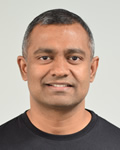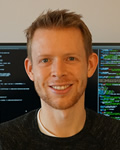
People to Watch 2018
Crystal Valentine
VP of Technology Strategy
MapR
 Crystal Valentine, PhD, is VP of Technology Strategy at MapR Technologies. She has nearly two decades’ experience in big data research and practice. A former professor of computer science at Amherst College, she is the author of several academic publications in the areas of big data, algorithms, and high-performance computing, and she holds a patent for Extreme Virtual Memory. Dr. Valentine was awarded the Silver Stevie Award in 2017 for Female Executive of the Year in the computer software category and is a member of the Forbes Tech Council. She has consulted extensively with Fortune 500 companies to design and implement high-throughput, mission-critical applications and with equity investors as a technical expert on competing technologies and market trends. Dr. Valentine was a Fulbright Scholar to Italy.
Crystal Valentine, PhD, is VP of Technology Strategy at MapR Technologies. She has nearly two decades’ experience in big data research and practice. A former professor of computer science at Amherst College, she is the author of several academic publications in the areas of big data, algorithms, and high-performance computing, and she holds a patent for Extreme Virtual Memory. Dr. Valentine was awarded the Silver Stevie Award in 2017 for Female Executive of the Year in the computer software category and is a member of the Forbes Tech Council. She has consulted extensively with Fortune 500 companies to design and implement high-throughput, mission-critical applications and with equity investors as a technical expert on competing technologies and market trends. Dr. Valentine was a Fulbright Scholar to Italy.
Datanami: Congratulations on being named a Datanami Person to Watch in 2018! The pace of technological change seems to be accelerating. As the VP of Technology Strategy at MapR, what advice can you give Datanami readers about preventing that pace of change from becoming overwhelming?
Crystal Valentine: Thank you so much. I’m incredibly humbled by this honor. Yes, the pace of technological change is remarkable, and that makes it a really exciting time to be in tech. The biggest challenge is to recognize that change is constant and it’s pretty much the only thing you can count on. I don’t know what the next 10 years will look like, but I do know that they will be different from the last 10.
The only rational strategy that an enterprise or an individual can have is to be resilient to change and agile to take advantage of new opportunities. For enterprises, that means choosing a strategy built on extensible technologies that can grow with you and that can provide optionality down the road. For individuals, that means being open to new points of view and new information. I love what Jeff Bezos said – “people who were right a lot of the time were people who often changed their minds… This doesn’t mean you shouldn’t have a well-formed point of view, but it means you should consider your point of view as temporary.”
Datanami: How do you see the rise of DataOps changing how we develop big data applications?
First, I think the term “big data” might be somewhat passé at this point. For many enterprises, building a “big data solution” that is separate from their legacy systems is unacceptable. It’s not about big data per se–it’s about all data. DataOps practices take enterprises to the next level by making them think holistically about their data as a corporate asset.
At its heart, DataOps is about embracing a data-first approach to application development. When I studied algorithms back in school, we assumed that CPU-time would be the dominant factor in a program’s running time; we focused on serial algorithms and mostly ignored the impact of data I/O on running time. Today, in the data era, we start with a distributed or parallel model of computation, and we assume that data access and data movement are going to be the most time-consuming parts of the program. It’s a totally different way of thinking about computation.
As enterprise applications have become increasingly data-intensive, DataOps was probably inevitable. Building a data-driven enterprise means not just using data to gain insights in an offline analysis. Instead, data-driven enterprises react quickly to opportunities in real time in a way that’s informed by data. DataOps practices promote self-service, agility, and continuous machine learning/data science model deployment. As a result, the enterprise becomes agile and resilient to changes in the market.
Datanami: You’ve been a vocal supporter of the need for diversity in big data. Do you think enough is being done to get female voices into the discussion?
I think of diversity in practical terms. When working on a hard problem, I talk to as many different people as possible to look at it from perspectives that are different from my own. If I only talk to people with similar ideas, then we will all get stuck in the same local optima. It’s important to be humble enough to acknowledge that the results of a well-balanced group of people collaborating together are going to beat the results of an individual genius. That’s the value of diversity in the workplace – it’s about bringing different perspectives together to collaborate on a single problem. It’s not just a gender issue; it’s about cognitive heterogeneity, which is good for business.
We are all inclined to place too much value on our “pattern recognition” skills when making hiring or investment decisions. For example, it’s tempting to make an investment in a company because the founder has been successful in the past (even if the technology and business model are totally different) or because the founder fits the mental model you have of a successful entrepreneur. Similar for hiring. The irony is that if all we bring to the table as hiring managers or investors is a skill for pattern recognition, then we don’t have a defensible competitive advantage over our peers. The more valuable skill is to recognize opportunities that others miss so that you can differentiate your company in the marketplace.
While the numbers of female leaders at technology companies certainly aren’t good today, I’m an optimist. The main challenge is that women opt out of careers in technology because they perceive that math and computer science are either hard, boring, or full of people lacking social skills (e.g. the archetypal lone hacker persona). Back when I was a professor of computer science, my department took some straightforward and practical steps to increase the percentage of majors who were female by combatting each of these presuppositions about computer science. We had remarkable success, so I know that there are strategies that work.
In the end, corporate culture comes from the top. If the CEO of a company thinks about building a well-rounded team, that will permeate the entire company. This way of thinking has to start with the CEO’s executive management team and the board of directors. The companies that figure that out are going to position themselves to do well.
Datanami: What do you hope to see from the big data community in the coming year?
I am hopeful that in the next year we will shift the conversation from “big data analytics” toward truly novel, disruptive applications. Since 2005, we’ve been hearing about how big data analytics is providing new insights that are valuable to companies. While that’s true, big data analytics applications, based on batch processing of large data sets, are not much different than traditional analytics or business intelligence applications; they just operate on more data.
Big data, real-time stream processing, and machine learning, will together form the holy trinity of the next generation of disruptive applications. At MapR, we’re working with companies training and deploying deep learning models for autonomous driving, doing real-time processing onthe edge in the oil field to optimize oil well output, and doing real-time machine learning on MRI images for personalized medicine applications. These fall well outside the realm of traditional database applications. I’m excited to see more of these types of applications coming to the fore in the coming year.
Datanami: Outside of the professional sphere, what can you share about yourself that your colleagues might be surprised to learn – any unique hobbies or stories?
I enjoy flying small planes. I took private pilot lessons during grad school, and I’ve been hooked ever since. In fact, my husband (who has his pilot’s license) and I flew ourselves from Boston to the Bahamas to get married. The beauty is that when you sit up front, you always get a window seat.






































